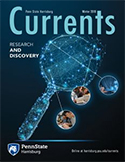Dr. John M. Mason Jr., a 1972 graduate of Penn State Harrisburg, returned to lead the campus in August 2018 after having served as vice president for research and economic development at Auburn University in Alabama. Prior to that, Mason served as an associate dean of the Penn State College of Engineering. During his time at Penn State, Mason was also a professor of civil engineering and director of the Pennsylvania Transportation Institute and the Institute for Advanced Studies in Transportation Engineering and Management.
Now eight months into his new role at his old home, Dr. Mason shares some experiences and answers the most frequently asked questions since his tenure as chancellor began.
On why he returned to Penn State Harrisburg
Penn State changed the trajectory of my life, and although I took a circuitous route to getting my first degrees, I truly benefitted from the vast network of resources that Penn State provides to students.
You hear people talk about being first generation college graduates, well I was a first generation high school graduate. Many in my family, including both of my parents, took jobs in local factories near my hometown in the Allentown area – my father worked in a cement factory and my mother in a dress factory. I assumed that after high school, I would follow a somewhat similar path. I enrolled in what was then Penn State Allentown with a plan to earn an associate’s degree and then get a job.
What I learned, though, was that my faculty members in Allentown had good connections with faculty at Penn State Harrisburg – known then as the Capitol Campus. The Harrisburg campus was fairly new at the time, and was unique in that you could go there to complete a bachelor’s degree after starting your first two years elsewhere. Thanks to the inspiration of faculty at both Penn State locations, I went on to earn my bachelor’s degree, and began a long journey in higher education.
I worked as a civil engineer for several years and then decided to return to school for a master’s and then a Ph.D. I eventually landed back at Penn State as a professor at University Park. I later became a dean in the College of Engineering and headed up several research institutes. So, I really have had a very well-rounded experience with many aspects of the University.
Following that, I spent ten years at Auburn University as vice president for research and economic development. But, I never lost my passion and affinity for Penn State, and I followed along closely as Penn State Harrisburg evolved so dramatically and
successfully. Being invited back to be considered as the new chancellor was an honor. I believe that my experience and understanding of Penn State are well suited to lead Penn State Harrisburg into its next phase, yet I remain humbled by the opportunity.
On changes at the college
There have been many! The first, of course, is the physical appearance. When I was here in the early 70s, there wasn’t much of a campus feel. The area was plain-looking – not much landscaping – with a few buildings, all of which were repurposed Air Force base structures. Today, Penn State Harrisburg looks like a college campus, with a beautiful quad, new buildings and enhanced spaces expressly designed to serve their particular purposes. All of this enhances our students’ experience here.
Another major change is the breadth of academic offerings. This campus has become one of the most comprehensive of the University’s campuses outside of University Park. When I was a student, the campus was a graduate program center and also offered the last two years of study – junior and senior year – at the undergraduate level. Today, a student can come to Penn State Harrisburg for a two or four-year degree, a master’s, or a doctorate in one of the college’s more than 65 academic programs.
All of this has led to another major change for the campus – the makeup of the student body. Over time, Penn State Harrisburg has become not only a destination for Pennsylvania students, but for students from the mid-Atlantic states, across the U.S. and around the world. Ours is one of Penn State’s most diverse campuses, with students from more than 40 states and 50 countries.
One of my earliest experiences since returning as chancellor, was when my wife and I, and our daughter, began meeting students and their families on move-in day. During those conversations, and in many since, I have been struck by the number of students who come here, not only because we offer access to a valuable Penn State degree, but because they are seeking our programs uniquely and because they are most comfortable in the type of campus community that has been established here.
On what is ahead for Penn State Harrisburg
This college has built a reputation for academic excellence. I expect that to continue to be enhanced. We will continue to focus on ways to make our students’ educational experiences superior, whether that is by affording them more internships and real-world learning opportunities, improving learning spaces on campus, supporting service-learning initiatives, or expanding leadership training, to name just a few. We have already taken steps to ensure that students have “a seat at the table” on college leadership bodies; this is another important type of real-life experience for interested students.
Research and scholarship inform teaching and are another way that our institution brings value to the region. There are numerous examples of current research projects that are improving our communities. Penn State Harrisburg faculty and students are working to create sustainable building materials, enhance local water quality, improve police and community
relations, and provide resources to stem opioid addiction – and these are just some of the examples. Going forward, I expect that we will position the college to expand research opportunities in all areas.
An important factor in enhancing research will be our ability to expand partnerships with public and private organizations, another college priority. By joining together with others, we can simultaneously advance the college mission and serve the needs of the region. Several efforts that have begun already meet these goals and utilize expertise from across the college.
One example is a smart home initiative. In its earliest stages, the vision is to create a premier institutional research and testing center for technologies, policies, and practices that enhance the quality of life in the home, especially for those with declining abilities or disabilities. This type of initiative can benefit industry partners – by providing data for informed decision-making and innovations for product development, for example. It can become a resource center for citizens and provide students with many hands-on learning opportunities.
Another example is the establishment of a Launchbox within our Center for Innovation and Entrepreneurship, part of the University’s Invent Penn State initiative. Through this initiative, the University is working to empower entrepreneurs from within and outside of Penn State and provide tools to bring great ideas to the marketplace. The goal is to have meaningful impact on student career success and to drive local economic development. Penn State Harrisburg, through its new Launchbox, is expanding its presence in Harrisburg and providing resources and services to new and expanding businesses in the region.
The opportunities for Penn State Harrisburg to continue to grow in all areas – whether enhancing students’ academic experiences or extending the college’s impact within the region – are limitless. We know that there will be challenges, of course. But, I am excited about the potential and I look forward to shaping the future of this campus, just as the campus helped shape my future.

